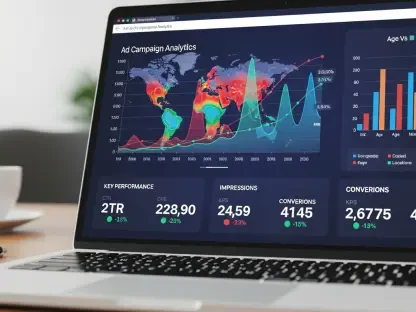Imagine a world where a single email could once fill ski resort bookings overnight, but now, even the most carefully crafted messages barely elicit a response from potential guests, signaling a dramatic shift in consumer behavior. This stark reality confronts Vail Resorts, a titan in the ski and hospitality industry, as it grapples with evolving trends that render traditional marketing tools obsolete. The company, known for its sprawling network of premier ski destinations, stands at a pivotal moment, compelled to redefine how it connects with guests in a digital age dominated by instant, personalized interactions. This shift signals not just a change in tactics, but a broader transformation sweeping across the hospitality sector, where adapting to new communication channels is no longer optional but essential for survival.
Understanding the Marketing Evolution in the Hospitality Industry
The hospitality and tourism sector, particularly within the niche of ski resorts, has undergone a dramatic marketing evolution over recent years. Ski destinations like Vail Resorts have historically relied on seasonal campaigns to attract guests, using direct communication to promote packages and experiences. However, the industry now faces a digital reckoning, where online presence and engagement are paramount in capturing the attention of a tech-savvy audience seeking unique, memorable getaways.
Effective communication strategies have become the linchpin for driving guest engagement and boosting revenue in this competitive landscape. Resorts must not only showcase their offerings but also build emotional connections with potential visitors, often through storytelling and immersive content. This need for deeper interaction has pushed companies to rethink how they reach their audience, moving beyond static advertisements to dynamic, real-time engagement platforms.
Key players in the industry, alongside technological advancements, are shaping this shift. Digital platforms, from social media to mobile apps, have become critical in meeting heightened consumer expectations for immediacy and personalization. Guests no longer settle for generic promotions; they demand tailored experiences that reflect their preferences, prompting resorts to leverage data and innovative tools to stay relevant in an ever-changing market.
The Decline of Email Marketing and Emerging Digital Trends
Changing Consumer Preferences and Communication Channels
The effectiveness of email as a marketing tool has notably diminished, a trend acknowledged by industry leaders at Vail Resorts and echoed by tech commentators. The company’s CEO has pointed out that what was once a reliable method for reaching guests over many years now struggles to cut through the noise of overcrowded inboxes. This perspective aligns with insights from tech writers who observe that email is losing ground as a primary outreach mechanism in both personal and business contexts.
In its place, messaging apps and social media platforms like TikTok have surged in popularity, offering more direct and engaging ways to connect. These channels cater to a growing preference for instant, visually rich content that resonates with younger demographics, a key target for ski resorts. Collaboration tools and other digital avenues are also gaining traction, reflecting a broader societal shift toward conversational and interactive communication over traditional formats.
Consumer behaviors are driving this pivot, as audiences increasingly seek authenticity and relevance in marketing efforts. The expectation for brands to be present on platforms where guests spend their time has forced companies to explore alternatives that foster genuine dialogue. This dynamic environment challenges resorts to adapt swiftly, ensuring they meet guests on their terms rather than relying on outdated methods.
Industry Data and Future Outlook
Across industries, data reveals a consistent decline in email’s marketing effectiveness, with hospitality feeling the impact acutely due to its reliance on direct guest communication. Studies indicate that open rates for promotional emails have dropped significantly, while engagement on social media and other digital channels continues to climb. For ski resorts, this trend underscores the urgency of diversifying marketing approaches to maintain visibility and influence.
Projections suggest that social media and personalized digital marketing will see substantial growth in the coming years, with estimates pointing to a sharp rise in ad spend on these platforms from the current year through at least 2027. These channels offer the ability to target specific demographics with precision, using algorithms and user data to craft messages that resonate deeply. For hospitality brands, this shift promises enhanced opportunities to attract and retain guests through tailored content.
Looking ahead, the implications for guest acquisition and retention are profound. Companies like Vail Resorts stand to benefit from adopting these modern tools, potentially transforming how they build loyalty and drive bookings. The focus will likely center on creating seamless, integrated experiences across multiple touchpoints, ensuring that every interaction feels personal and relevant to the individual guest.
Challenges in Adapting to a New Marketing Landscape
Transitioning from email to a multi-channel digital strategy presents significant hurdles for Vail Resorts. The move requires a fundamental overhaul of existing marketing frameworks, which can be both costly and complex. Integrating new platforms demands not only financial investment but also a cultural shift within the organization to embrace innovative practices over familiar routines.
Internally, challenges include outdated systems that may not support advanced digital tools, alongside the need for comprehensive staff retraining to master these technologies. Externally, the fragmented digital landscape poses difficulties in maintaining a cohesive brand voice across diverse platforms. Navigating this terrain requires careful planning to avoid diluting the company’s message or confusing potential guests.
Solutions lie in leveraging existing guest data to inform strategy and investing in scalable technology that supports personalized experiences. By prioritizing data analytics, resorts can better understand guest preferences and tailor campaigns accordingly. Additionally, partnerships with tech providers can streamline the adoption of new systems, helping to bridge gaps in capability and ensuring a smoother transition to a modern marketing approach.
Navigating Compliance and Data Security in Digital Marketing
The regulatory landscape for digital marketing is increasingly stringent, with data privacy laws shaping how companies handle guest information. Compliance with regulations such as the General Data Protection Regulation and various regional standards is critical for resorts engaging in personalized advertising. Failure to adhere to these rules can result in significant penalties and damage to reputation.
Securing guest data is paramount as Vail Resorts intensifies its use of analytics for targeted campaigns. With greater reliance on digital tools comes the responsibility to protect sensitive information from breaches and misuse. Implementing robust cybersecurity measures and transparent data practices is essential to safeguard trust while maximizing the potential of data-driven marketing.
Adherence to compliance standards can also serve as a competitive advantage, building credibility with guests who value privacy. By demonstrating a commitment to ethical data use, resorts can foster stronger relationships with their audience. This balance between innovation and responsibility allows for creative marketing initiatives that respect guest boundaries while pushing the envelope on engagement.
Future Directions for Vail Resorts in Digital Marketing
The path forward for Vail Resorts and the broader hospitality industry lies in embracing a diversified marketing toolkit. Emerging opportunities include influencer partnerships that amplify brand reach through authentic endorsements, as well as social media campaigns that capitalize on viral trends to capture attention. These strategies offer fresh ways to connect with audiences who prioritize peer recommendations and engaging content.
Targeted TV ads also hold potential as a complementary channel, blending traditional media with digital precision to reach specific demographics. Such a multi-faceted approach ensures that marketing efforts are not confined to a single platform but instead create a web of touchpoints that reinforce brand presence. This synergy is particularly effective for niche offerings like ski experiences, which benefit from both broad awareness and tailored messaging.
Data-driven precision marketing, including techniques like lookalike modeling, will play a central role in reaching new audiences. By analyzing existing guest profiles to identify similar prospects, resorts can expand their customer base with accuracy. This focus on analytics promises to drive growth by ensuring that marketing resources are allocated to the most promising segments, optimizing return on investment.
Conclusion and Strategic Recommendations
Reflecting on the journey, Vail Resorts embarked on a bold transition from outdated email marketing to a vibrant, multi-channel digital strategy, acknowledging the limitations of past methods. This pivot responded to undeniable shifts in consumer behavior that demanded more immediate and personalized interactions. The exploration of new platforms and data tools marked a significant step in redefining guest engagement within the hospitality sector.
Looking ahead, actionable steps emerged as critical for sustaining this momentum. Investment in advanced data analytics stood out as a priority to refine targeting and enhance campaign effectiveness. Simultaneously, adopting a robust multi-channel framework ensured that no opportunity for connection was missed, spanning social media to traditional media with equal finesse.
Finally, a commitment to personalized content became the cornerstone for future success, urging the industry to craft messages that truly resonated with individual guests. By focusing on these strategic areas, Vail Resorts positioned itself to not only adapt but thrive amidst digital evolution. The path forward invited continuous innovation, encouraging a proactive stance in anticipating and meeting the ever-changing expectations of the modern traveler.









